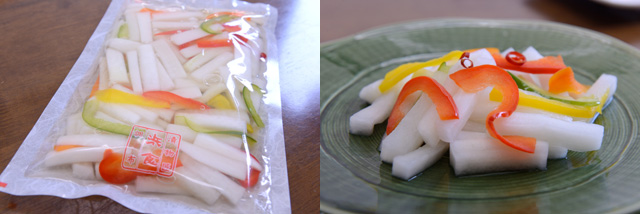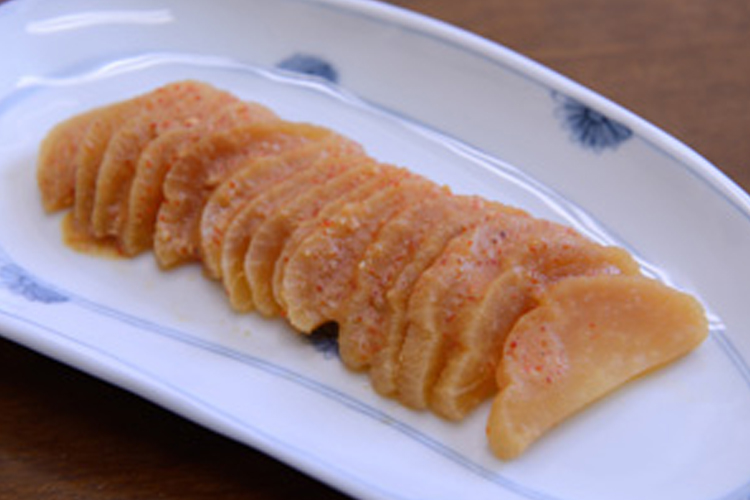Tsukemono (Japanese pickles): A Traditional Japanese Preserved Food
May 08,2014
Tsukemono (Japanese pickles): A Traditional Japanese Preserved Food
May 08,2014

It is only recently that vegetables, fruit, fish and shellfish have become available year-round. Until the advent of freezing and logistics technologies, we could only eat what was available at that time of year.
If you live in a warm location where fresh food is always available, you could live off seasonal produce alone, but there are many places in the world where securing ingredients is difficult for long periods of the year due to climate and other reasons. Preserved foods were developed to cope with this. Fresh ingredients are prepared in advance by processing them using techniques such as fermentation, drying and smoking. Today, many preserved foods are being adapted and produced in countries all over the world.
We are on a journey to explore preserved foods, wisdom for everyday life that support the foundations of culinary culture.
In Part 7, we delve into otsukemono, an essential part of Washoku (Japanese cuisine)
▶Katsuobushi (dried bonito flakes): A Traditional Japanese Preserved Food
▶Okinawan preserved foods: Traditional Japanese Preserved Food

Otsukemono comprises a variety of foods that have been marinated in salt, vinegar, miso or other similar ingredient to help them keep longer while also improving their flavor through maturation.
There are various otsukemono particular to different areas of the world. For instance, kimchi in Korea, mian ma and zha cai in China, sauerkraut in Germany and pickles in the UK and US. A variety that developed particularly in Japan is furuzuke, a kind of otsukemono in which fresh vegetables at their peak are preserved in salt and then de-salted before consumption. The technique for making furuzuke was perfected at the end of the Edo period of Japan’s history (1603–1867), and passed down in Japanese families until around the mid-20th century.
After the war, it became more difficult to pass the otsukemono method down from parent to child due to changes in the family environment and the family itself, and store-bought otsukemono flourished. Hamashoku (established 1960), which we visit in this article, is one such manufacturer. You might say that they have taken over the otsukemono making that wives and grandmothers used to do for them, in line with today’s needs.
Hiramatsu Takayoshi is the company’s Director & General Manager, Production . He entered the product to that won through to represent the Kanto region in the 4th T-1 (Takuwan) Grand Prix held this February.
“As times have changed, people have come to prefer less salty otsukemono. In addition to the saltiness, the acidity has also reduced and, subsequently, the sweetness increased. Rather than asazuke (lightly pickled vegetables), they are more like a salad.”
Pictured in the photo at the start of this article is a prototype made with daikon radish and bell peppers called Spanish Colors Marinated in Sweet Vinegar. It is different to traditional otsukemono from the name on, and I think its flavor is a better match for pasta than rice.
The fact that seasons no longer matter is another huge change for the otsukemono market.
“Take daikon, for instance. The otsukemono we ship in summer is also produced using umami-rich daikon harvested in the winter. But if we want to procure daikon in the summer, we can get them from Hokkaido or the Tohoku region. Elementary school students who visit on factory tours see daikon in supermarkets year-round and aren’t aware that they are a winter crop [laughs]. The otsukemono market no longer has a sense of seasonality; that in summer it’s eggplant and cucumber and in winter it’s daikon and Chinese cabbage.”


Cantaloup, apple, gōya (bitter melon), shallot… Such exotic ingredients make fine otsukemono.
“We harvest and marinate cantaloup while it is still smaller than a baseball ball, before it develops its net-like skin. Once they are bigger, their skin and seeds become hard and they are no longer suitable for making into otsukemono.”
With a crunchy bite and mild flavor, you’d never guess it was a gourd if you hadn’t been told. But it definitely retains a certain meloniness.
“Shallots are early-picked scallions. A popular summer product, tomatoes, too, are harvested before they become full flavored. To let the flavors seep in, the tomatoes are peeled in bath of boiling water before they are marinated. Mini (cherry) tomatoes are too small and are hard to peel, and regular tomatoes are too large when you want to eat them, so we use specially-ordered tomatoes that are the size of a golf ball.”
The more new products you send to market, the more failed products you get, apparently.
“Zucchinis take well to being made into otsukemono, but they did not sell so well. The reason was that they don’t taste the way they look. They look like cucumbers, but taste like eggplant [laughs]. It brought it home to me that zucchinis are an ingredient you want to pan-fry and eat.”
It seems the response to tropical fruits like papaya and mango was so-so, too. Only a few select ingredients become staple seasonal products the way cantaloup and tomato have.

Misozuke Daikon (miso-marinated daikon) (in the bottom right photo), is a modern otsukemono that makes you hungry for rice. It is low on salt, but has a good balance between salty and sweet. I asked Hiramatsu-san how it’s made, and the process is quite elaborate.
Procure ingredient (domestic shirokubi daikon) → washing → peeling → salt marinading (3 days) → washing → preliminary marinating (3 days) → miso marinating (3 days) → selection, bag filling, vacuum sealing → metal detector → heat sterilization (75°C for 20 minutes) → cooling → visual inspection → boxing → shipping.
“Such things as the marinating ingredients and heat sterilization time vary from product to product. At Hamashoku, we have around 80 product recipes. Unfortunately, consumption of otsukemono has been declining year by year, even as techniques for producing otsukemono have advanced. We see continuing to protect traditional Japanese food as a mission.”
To Japanese people, the sound and crunch when they take a bite of otsukemono are unforgettable. Let’s brighten up the dining table with modern otsukemono.
▶Katsuobushi (dried bonito flakes): A Traditional Japanese Preserved Food
▶Okinawan preserved foods: Traditional Japanese Preserved Food
